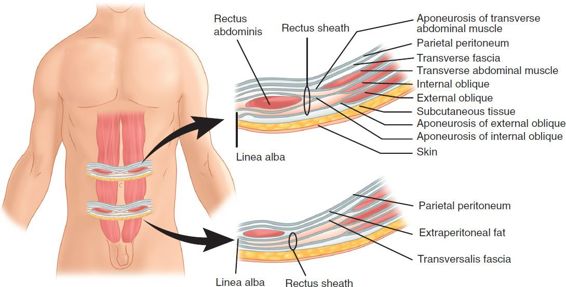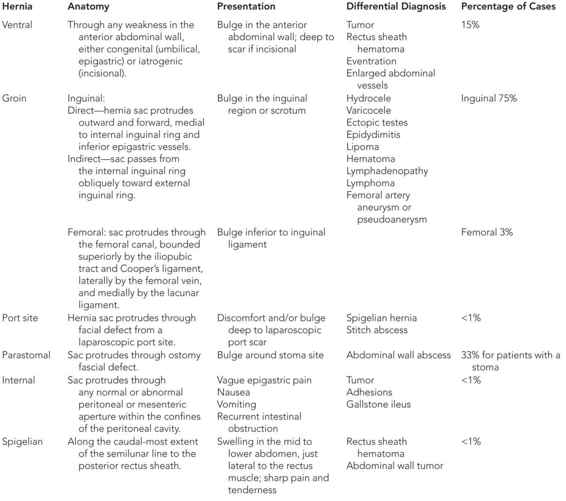HERNIAS
CASE SCENARIO
A 74-year-old man presents to the emergency department with nausea, vomiting, and altered mental status. His wife states that he developed diffuse abdominal pain approximately 36 hours ago, followed by non-bloody emesis. He has been unable to keep any food or fluids down.
The patient is afebrile and tachycardic to 110, and his blood pressure is 95/63. On careful abdominal examination, he is distended and diffusely tender. A firm, tender bulge is palpable in his left groin. Labwork is notable for a BUN of 45, creatinine of 2.0, and lactate of 5.2.
EPIDEMIOLOGY
Management of abdominal hernias is among the most common surgical issues. The lifetime incidence of spontaneous abdominal wall hernias internationally is 5% to 10%.1 Groin hernias are the most common, accounting for about 75% of cases.1 Of the remaining hernias, about 5% are femoral and 15% are incisional hernias. Port site, parastomal, Spigelian, and a number of miscellaneous hernias account for the final 5%. Eight hundred thousand inguinal hernia repairs are performed in the United States annually.2
The majority of inguinal hernias occur in males, with a male-to-female ratio of approximately 7:1. Although the incidence of femoral hernias is higher in women than men, with a ratio of 1.8:1, inguinal hernias are the most common groin hernias irrespective of gender. Incisional hernias are also twice as common in women.
PATHOPHYSIOLOGY
A hernia is defined as an abnormal protrusion of an organ or tissue through a defect in its surrounding wall. These defects occur most commonly in the abdominal wall, at sites where the aponeurosis and fascia are uncovered by striated muscle. Hernias can arise congenitally (inguinal, femoral, umbilical, linea alba, lower portion of the semilunar line) or iatrogenically (sites of prior incisions, laparoscopic ports, or stoma sites) (Figure 18–1). Abdominal wall hernias are linked to patient-related factors that predispose to increased intra-abdominal pressure including obesity, older age, sleep apnea, emphysema, and prostatism. Postoperative patients who suffer a surgical site infection also have double the risk of developing an incisional hernia.3
Figure 18–1 Diagram of the layers of the abdominal wall, above (top right) and below (bottom right) the semilunar line. Possible sites of herniation include the umbilicus, the linea alba, below the semilunar line, and the femoral and inguinal canals, as well as prior surgical incisions. (Reproduced with permission from Moore KL, Daily AF (eds): Clinically Oriented Anatomy, 4th ed. Philadelphia: Lippincott, Williams, & Wilkins, 1999.
Internal hernias, including paraduodenal, pericecal, foramen of Winslow, transmesenteric, and retro-anastamotic, are protrusions of viscus through peritoneal or mesenteric defects within the peritoneal cavity. Such apertures can be acquired, as in a post-surgical, traumatic, or post-inflammatory defects, or congenital, including normal openings such as the foramen of Winslow, and abnormal openings arising from anomalies of internal rotation and peritoneal attachments.
CLINICAL PRESENTATION
Hernias can present in one of three stages: reducible, incarcerated, or strangulated. A hernia is reducible when its contents return to their original location either spontaneously or with gentle pressure. In contrast, an incarcerated hernia cannot be reduced, and if associated with pain or bowel obstruction, warrants urgent surgical repair. Acute incarceration can compromise perfusion to hernia contents and progress to strangulation, with intestinal ischemia and necrosis. Strangulation is more likely with large hernias that have a small orifice, and represents a surgical emergency.
Clinical presentation depends on specific anatomy. Abdominal wall hernias may present as bulges in the groin (inguinal, femoral) around the umbilicus (umbilical) or at sites of surgery (incisional, port site, parastomal), while internal hernias are seldom identifiable on physical examination. Reducible hernias may be associated with pain or vague discomfort. In contrast, incarcerated and strangulated hernias can present with intense pain, bowel obstruction, and overlying skin changes such as erythema and heat, which are signs particularly concerning for the underlying ischemia.
DIFFERENTIAL DIAGNOSIS
Differential diagnosis depends on patient age and hernia location. Groin hernias require differentiation from hydrocele, varicocele, undescended testis, tumor, femoral artery aneurysm, lipoma of spermatic cord, inguinal lymphadenopathy, or psoas abscess. Ventral and incisional hernias can be confused with lipomas, rectus sheath hematomas, tumors, or soft tissue abscesses. Morbid obesity complicates detection of hernias by physical examination, and this subset of patients often require imaging. Internal hernias are often difficult to diagnose because of their dynamic nature, and generally become apparent only when they cause bowel obstruction (Table 18–1).
WORKUP AND CHOICE OF IMAGING
Assessing for strangulation is paramount, as strangulated hernias require emergent surgery to limit bowel necrosis and sepsis. In most cases, a careful physical examination is sufficient for diagnosis. However, in the case of an unclear diagnosis or a possible occult hernia (Spigelian, internal, etc.) a number of imaging modalities can assist.
 Ultrasound
Ultrasound
Ultrasound is useful in the diagnosis of anterior abdominal wall and groin hernias, with a sensitivity and specificity approaching 100% for the latter.4 As a real-time examination, ultrasound allows for data acquisition during Valsalva and other maneuvers that elicit hernia symptoms and can also detect peristalsis in herniated bowel. Ultrasound also has the ability to determine reducibility, as well as tenderness of the hernia with compression during the examination. Two drawbacks are that fascial defects can be difficult to identify, and visualization of mesenteric or omental fat is often nonspecific.
 Computed Tomography Scan
Computed Tomography Scan
For patients who manifest symptoms of a bowel obstruction (nausea, vomiting, obstipation, abdominal distension), a computed tomography (CT) scan with oral and intravenous contrast can be helpful in determining the level and severity of bowel obstruction. Even in the absence of bowel obstruction, a CT of the abdomen and pelvis remains the best available imaging tool for evaluation of the acute abdomen and abdominal hernias, especially internal hernias. Having patients perform a Valsalva maneuver during a fast helical sequence can increase sensitivity, since many hernias spontaneously reduce if the patient lies relaxed in the supine position during the scan. Using CT scans, the sensitivity in detecting abdominal wall hernias is reported as 83%, with specificity between 67% and 83%.5 The advent of higher-resolution multi-detector CT scanners, which capture finer anatomic detail, has likely improved these statistics.
 Magnetic Resonance Imaging
Magnetic Resonance Imaging
Though generally not a first-line imaging technique, magnetic resonance imaging (MRI) allows for detailed display of muscular anatomy. Such images may be useful in cases difficult to characterize by CT or ultrasound, or for patients wishing to avoid ionizing radiation (due to pregnancy, etc.). The time required for acquisition limits the utility of MRI in the acute setting.
IMAGING FINDINGS
 Ultrasound
Ultrasound
Ultrasound is most useful in abdominal wall hernias to detect fascial defects and hernia sacs. Defects are most apparent as a break in the echogenic shadow of the fascia. Ultrasound is especially effective in the identification of Spigelian hernias and occult inguinal and femoral hernias. For groin hernias, important anatomy must be identified—the inguinal ligament, femoral canal, inguinal canal with content of spermatic cord or round ligament, inferior epigastric vessels, conjoint tendon, deep and superficial inguinal rings. Patients are scanned supine in the relaxed state, as well as during coughing and during a Valsalva maneuver. Hernias are identified in two ways: the hernia sac can be identified containing omentum or bowel with a cough impulse, or the hernia sac appears on Valsalva maneuver.4,6
Because of the dynamic nature of ultrasound, small bowel can be identified in a hernia sac by its peristalsis. Peristalsis is the wavelike muscular contraction of the small bowel, and is very sensitive for the identification of small bowel in a hernia. However, it should be noted that absence of peristalsis does not mean absence of bowel within a hernia sac. In fact, large bowel or obstructed small bowel will not contract (Table 18–2 and Figure 18–2).









